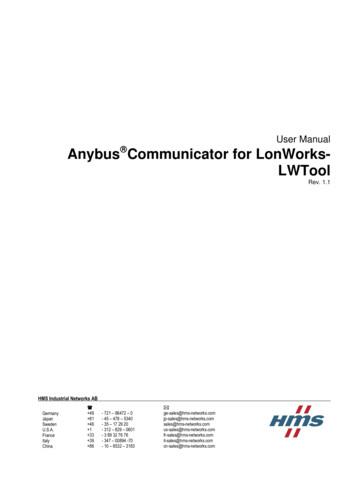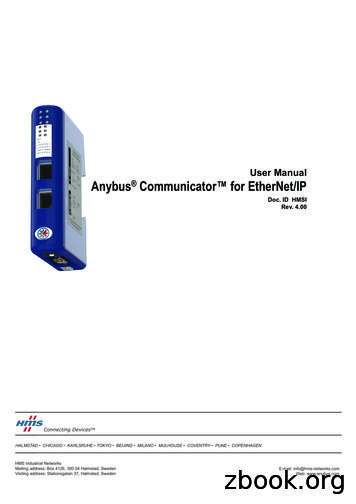Using A HMS Anybus Ethernet Communicator With An Allen .
!" # Using a HMS Anybus Ethernet Communicator with an AllenBradley SLC 5/05 ControllerApplication SummaryThis document explains the procedure for configuring communications between an AllenBradley SLC 5/05 and the HMS Anybus Ethernet Communicator. Through a messageinstruction called the Ethernet/IP Explicit Message (EEM) in the SLC 5/05 processor, it ispossible to read and write data from an Anybus Ethernet Communicator.Application Equipment and MaterialsMaterials used in the development of this application note are as follows: Hardware used in development of application note: HMS Anybus CommunicatorEthernet to Serial Gateway (HMS part no. AB7007), Allen Bradley SLC 5/05processor with OS firmware level Series C, FRN 10 (AB part no. 1747-L553) Software used in the development of application note: HMS ABC ConfiguratorSoftware Version 2.22, RsLogix 500 Pro Software Version 7.10 Documentation consulted: Anybus Communicator Ethernet User Manual ver. 2.10,Allen Bradley Publication 1747-RM001E-EN-P January 2006. Appropriate Programming Cables (AnyBus Configurator Cable, Ethernet Cable)Anybus Communicator IO SizeIn this example, the Anybus Communicator was setup for 14 bytes of Input data and 7bytes of Output data. The serial configuration setup for each application in the AnybusCommunicator is going to have a different amount of bytes. To check the amount of Inputand Output bytes in the application, right click on the Sub-Network and select “SubNetwork Monitor” as shown in figure1 below.Figure 1% #&(') *% * &,-
!" # A Sub-Network Monitor screen should now appear. This will show the number of Inputbytes (14) and the number of Output bytes (7) in the Anybus Communicator. If there areno colored boxes, this means that the Anybus Communicator has not been setup yet.Proceed to setup the serial interface of the Anybus Communicator before going on.Figure 2SLC 5/05 SetupCommunicating to the Anybus Communicator for Ethernet is done through a Ethernet/IPExplicit Message (EEM) message instruction. The EEM instruction can be used with anySLC 5/05 processor at OS firmware level Series C, FRN 10 or higher. The EEM messageinstruction is a control block for storing the instruction parameters and configuration setupscreen, similar to a MSG instruction. The Ethernet CIP command consists of a ServiceCode; the object Class, Instance and Attribute and the Send/Receive Data.First, to read the Input bytes in the Anybus Communicator, add an EEM messageinstruction in RsLogix 500. Under, the General tab set the size of the words and the datatable address in the message instruction. The service code for a “Read” is an “E” inhexadecimal. The class for the inputs on the Anybus Communicator is 4, with the instancebeing 64 (hex) and attribute being 3. Also, adjust “Size in Words (Receive Data)” to 124. Itshould look similar to Figure 3.% #&(') *% * &,-
!" # Figure 3Figure 4% #&(') *% * &, .-
!" # Next, select the “MultiHop” tab. In this tab, enter the IP address of the AnybusCommunicator. Save the program and download to the SLC 5/05. This messageinstruction should now read the 14 input bytes and place them in the N10:0 data tableaddress.Now, in order to write to the output data in the Anybus Communicator, add an EEMmessage instruction again to RsLogix 500. Under the “General” tab, the service code willnow be 10 (hex). Set the send data size, along with the data table address. In thisexample, a size of 3 with N11:0 is being used. On the Anybus Communicator, the Class is4, with the Instance being 96 (hex) and Attribute being 3. This is shown in Figure 5 below.Figure 5Next, select the “MultiHop” tab and type in the IP address of the Anybus Communicator.Under the “Send Data” tab will be the data that gets sent to the Anybus Communicatormodule. This is shown in Figure 6.% #&(') *% * &,-
!" # Figure 6When the message instruction gets executed, the following output values will get sent tothe Anybus module. To view the current input and output data that’s on the AnybusCommunicator, right click on the Node and select “Node Monitor” as shown below inFigure 7. A monitor screen will appear, showing the input and output bytes in grey.Figure 7% #&(') *% * &,-
!" # Figure 8The data shown inside the gray boxes is actual data that is inside the Anybus module.After the message instruction has been executed, the data values set earlier in themessage instruction, can now be seen in the output table in the Anybus Communicatorthrough Node Monitor.Figure 9% #&(') *% * &, /-
!" # If problems exist, verify cable connection and make sure the communication parametersmatch between the SLC 5/05 and the Anybus Communicator. If troubles continue, callHMS Industrial Networks for technical support.Web References: www.hms-networks.com http://www.ab.com/HMS Sales and Support OfficesUnited States: 1 773 404 3486Germany: 49 721 964 720Japan: 81 45 478 5340Sweden: 46 35 17 29 00% #&(') *% * &, --
Documentation consulted: Anybus Communicator Ethernet User Manual ver. 2.10, Allen Bradley Publication 1747-RM001E-EN-P January 2006. Appropriate Programming Cables (AnyBus Configurator Cable, Ethernet Cable) Anybus Communicator IO Size In this example, the Anybus Communicator was setup for 14 bytes of Input data and 7 bytes of Output data. The serial configuration setup for each .
Communicator User Manual . Anybus Communicator for Ethernet, User Manual 4.00 . Power supply 24VDC n.a. n.a Configuration cables n.a. n.a. Anybus Configuration Manager 4.3.1.1 HMS Industrial Networks AB Page 4 (17) ABC EtherNet/IP Adapter with RSLogix 5000 Doc: HMSI-27-296, Rev: 2.11 2.Solution overview This application note describes how to configure an Anybus Communicator EtherNet/IP adapter .
User Manual Anybus Communicator for LonWorks- LWTool Rev. 1.1 HMS Industrial Networks AB Germany ge Japan jp Sweden sales@hms U.S.A. us France fr Italy it China cn 49 - 721 –96472 0 81 - 45 –478 5340 46 - 35 –17 29 20 1 - 312 –829 0601 33 - 3 89 32 76 76 39 -347 –00894 70 86 - 10 –8532 3183 -sales@hms networks.com-sales@hms networks.com-networks.com-sales@hms networks.com .
Web: www.anybus.com User Manual Anybus Communicator for EtherNet/IP Doc. ID HMSI Rev. 4.00. Important User Information This document contains a general introduction as well as a description of the technical features provided by the Anybus Communicator, including the PC-based configuration software. The reader of this document is expected to be familiar with PLC and software design, as .
Documentation consulted: Anybus Communicator Ethernet User Manual ver. 2.04, Allen Bradley Publication 1763-UM001B-EN-P April 2007. Appropriate Programming Cables (AnyBus Configurator Cable, Ethernet Cable) Anybus Communicator IO Size In this example, the Anybus Communicator was setup for 8 bytes of Input data and 3 bytes of Output data. The serial configuration setup for each .
Anybus Communicator CC-Link User Manual Doc: HMSI-27-304, Rev. 3.11 Chapter 1 1. About the Anybus Communicator for CC-Link The Anybus Communicator for CC-Link acts as a gateway between virtually any serial application pro-tocol and a CC-Link-based network. Integration of industrial devices is enabled without loss of func- tionality, control and reliab ility, both when retro-fitting to existing .
Note for the Anybus X-gateway and Communicator: The switches will be found next to the power connection on the X-gateway and next to the indication LEDs on the Communicator. Rotary switches 1-2 set the MAC ID. For further instructions see the Anybus Communicator User Manual and the X-gateway Manual Addendum. Note for the Anybus-S Slave module:
Web: www.anybus.com User Manual Anybus Communicator for PROFINET Doc. Id. SCM-1200-088 Rev. 3.01. Important User Information This document contains a general introduction as well as a description of the technical features provided by the Anybus Communicator, including the PC-based configuration software. The reader of this document is expected to be familiar with PLC and software design .
Abstract—Agile Software Development (ASD) has been on mainstream through methodologies such as XP and Scrum enabling them to be applied in the development of complex and reliable software systems. This paper is the end result of the Master’s dissertation of the main author, and proposes a solution to guide the development of complex systems based on components by adding exceptional .























